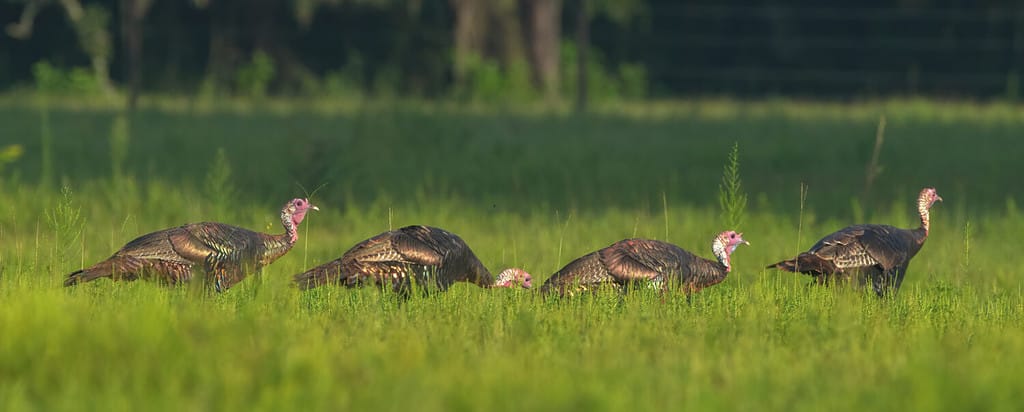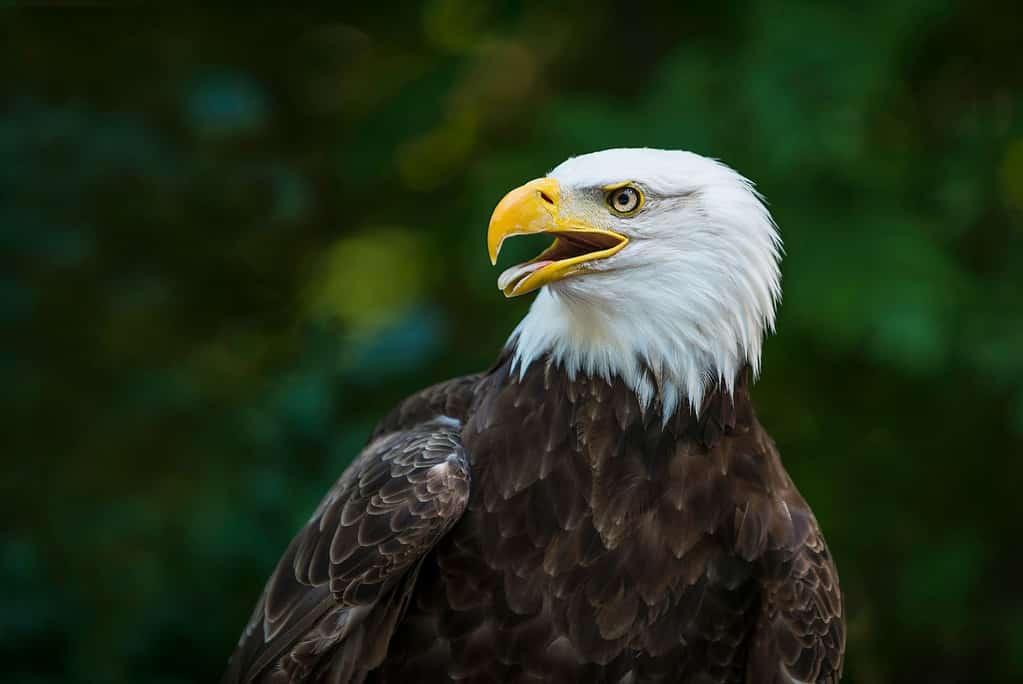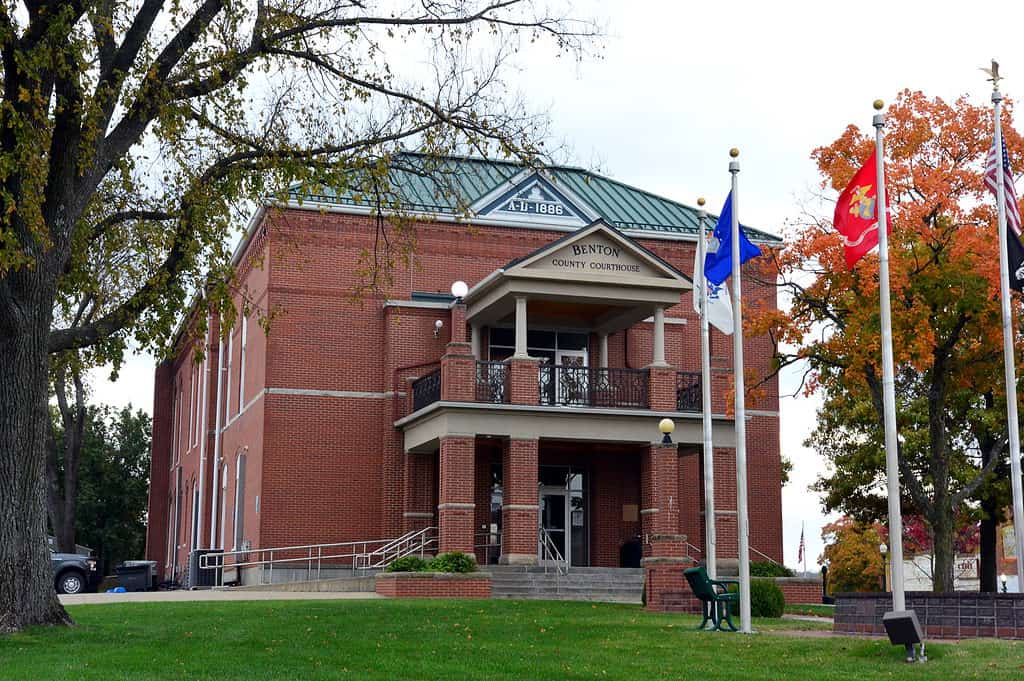The hottest temperature ever recorded in Missouri was 118 degrees Fahrenheit. The state saw this scorching temperature on July 14, 1954 in two towns. Both Warsaw, Missouri, and Union, Missouri reached 118 degrees Fahrenheit as part of a long heat wave in the record-breaking summer.
The Climate of Missouri

Missouri is a midwestern state with a continental climate, which includes four distinct seasons.
©iStock.com/fotoguy22
Despite the hottest temperature in Missouri being a scorching 118 degrees, the state rarely reaches such extremes. Missouri is a midwestern state with a continental climate, which includes four distinct seasons. Missouri’s winters are cold, with the possibility of humid air, snowfall, and freezing rain. Missouri’s summers are moist and warm, with frequent rain showers and occasional periods of drought. Though there are regional differences in Missouri’s weather, these are not based on clear geographic boundaries. Rather, the regional climates blend into each other.
As an inland North American state, Missouri has frequent weather changes, including oscillating temperatures. Temperatures above 100 degrees Fahrenheit are rare, but each part of the state has recorded high temperatures over 100 degrees. The highest-recorded temperatures in Missouri have been in the northern and western parts of Missouri.
The Hottest Temperature in Missouri
The highest recorded temperature in Missouri’s history was on July 14, 1954. The state’s record-breaking temperature of 118 degrees Fahrenheit occurred in the cities of Warsaw and Union. These cities are about 130 miles apart as the crow flies, though much further when driving. Union, Missouri typically experiences hot July weather, with a typical day easily reaching 92 degrees Fahrenheit. Warsaw does not get quite as hot but regularly experiences summer temperatures in the 80s and 90s.
Warsaw is also unique for holding both the highest and the lowest record temperatures in Missouri. In addition to having seen the hottest temperature on record, on February 13, 1905, Warsaw dropped to an incredible -40 degrees Fahrenheit. To this day, this is the lowest temperature recorded in Missouri history. Holding both of these records makes Warsaw one of two cities in the United States to have seen both the hottest and coldest temperatures in the state. The other record-holder is Millsboro, Delaware.
Though Warsaw and Union saw the hottest temperatures in the state, other cities throughout Missouri also experienced their own record-breaking heat. On July 14, 1954, St. Louis saw the thermometer at Lambert Field soar to 115 degrees Fahrenheit. This made the day the hottest in St. Louis’s history.
July 14 was the last day of a week-long heat wave that claimed numerous lives, including 104 people who died in St. Louis alone. 137 people died throughout Missouri in June and July 1954, during the historic heat wave. It was only on July 15 that cool winds from Canada caused the state’s temperatures to drop. St. Louis went from 115 degrees on July 14 to 76 degrees by 6 o’clock the next morning. In fact, three of the top 10 hottest days in St. Louis history, three were in July 1954, with July 18 reaching 112 degrees and July 12 reaching 110 degrees. The summer heat of 1954 followed a severe drought in 1954, in which Missouri experienced very little rain. The central Midwest has not seen such a long and widespread period of extreme heat since the 1950s.
Will the Hottest Temperature in Missouri Happen Again?
Though it is difficult to predict whether Missouri will see such record-breaking temperatures again, if the state saw a heat wave with temperatures over 118 degrees Fahrenheit, the consequences could be significant. First, several factors could exacerbate the negative impact of an extended heat wave. For example, the population growth since 1954 and the amount of energy the population uses for air conditioning has increased significantly. Back in the summer of 1954, such hot temperatures caused deaths, particularly among vulnerable populations such as hospital patients and the elderly. Many others simply suffered from discomfort in the heat. However, the communities did adapt by seeking out public places with air conditioning, swimming in pools, and purchasing cold drinks and cooling devices like fans.
If the state saw another heat wave or surpassed the current hottest temperature in Missouri history, it is possible there would be a shortage in water, or in electricity, strained by an increase in demand during a heat wave.
The History of Union, Missouri, and Warsaw, Missouri
Union, Missouri
Union is a city in Franklin County, Missouri. The county began when organizers separated the area from St. Louis County and named their new county after Benjamin Franklin, the famous American founding father. Franklin County is one of the largest counties in Missouri and the St. Louis metropolitan area. Union was established on January 22, 1825, becoming the County Seat. The city gained its name as a testament to the joining together of people in the centrally-located area in the county.
Dating back to the 1800s, Union has been a manufacturing and railroad town. This town is uniquely famous for being one of the biggest producers of corn cob pipes! Today, about 12,500 people call this quaint town of Union home.
Warsaw, Missouri
Warsaw is a city in Benton County, Missouri. This rural town has a rich history as well. The area that would become Warsaw was settled in 1820 by farmers, and the town quickly became a hub for travel and commerce. Not only was the railroad instrumental to the area’s development, but the first ferry on the Osage River was built in 1831 by Lewis Beldsoe, at the current Bledsoe Ferry Park stands today. Eventually, many ferries and stagecoaches would pass through the area.
Benton County was created in January 1835, from Pettis and Green Counties, and named after Thomas Hart Benton. Thomas Hart Benton was a U.S. Senator from Missouri. Warsaw became the County Seat in 1843. This tiny town is currently home to only about 2,200 residents.
Ecology and Wildlife

Hunters visit Warsaw, Missouri, to hunt wild turkeys.
©Chase D’animulls/Shutterstock.com
In Warsaw and Union, as well as the broader state of Missouri, diverse wildlife abounds. You may find birds like the black vulture, turkey vulture, bald eagle, great blue heron, eastern kingbird, house finch, northern bobwhite, tree swallow, summer tanager, and even wild turkey.
You can look for reptiles, such as the little brown skink, ornate box turtle, common box turtle, ring-necked snake, prairie lizard, North American racer, speckled king snake, coachwhip, painted turtle, eastern milksnake, eastern copperhead, timber rattlesnake, great plains rat snake, northern cottonmouth, and diamond watersnake, among many others. As you may notice, Missouri is home to a great many snakes, including several which are venomous.
When it comes to mammals, Missouri has numerous species that call the state’s wilderness home. Look out for armadillos, groundhogs, fox squirrels, coyotes, southern flying squirrels, American beavers, muskrats, gray foxes, American mink, many species of shrews, badgers, long-tailed weasels, many species of bat, southern bog lemmings, jackrabbits, and many other small rodents.
Hunters often visit the area to hunt whitetail deer, turkey, rabbit, dove, and quail, where these animals thrive in the Truman Lake and Lake of the Ozarks region.
Missouri has many amphibians in and around its rivers and lakes. These include American toads, American bullfrogs, eastern newts, southern leopard frogs, green treefrogs, four-toed salamanders, spotted salamanders, long-tailed salamanders, common mudpuppies, and many more.
Animals that Thrive in Heat
Some of the animals listed above will not survive and thrive in conditions of extreme heat, such as the hottest temperature in Missouri, 118 degrees. Others thrive, such as some of Missouri’s reptile species and large mammals. Smaller wildlife, particularly those that need ample water for their habitat, may suffer most in heat waves and droughts. This may put birds, amphibians, and fish at-risk in extreme heat.
Threatened Species in Missouri

Missouri is home to endangered and threatened species, including the bald eagle.
©iStock.com/hsun337 – License
Of all of Missouri’s wildlife, quite a few species are considered endangered or threatened. Animals on the “threatened” species list that live in Missouri include the common box turtle, black vulture, bald eagle, eastern meadowlark, loggerhead shrike, four-toed salamander, cooper’s hawk, green treefrog, horned grebe, European carp, sharp-shinned hawk, marsh wren, timber rattlesnake, chimney swift, the American badger, long-tailed weasel, tiger salamander, hellbender, and lake sturgeon.
Things to Do in Missouri

The Benton County Courthouse in Warsaw, Missouri is a testament to the state’s long history.
©Kbh3rd, CC BY 4.0 <https://creativecommons.org/licenses/by/4.0>, via Wikimedia Commons – License
Visit the towns that once had the hottest temperature in Missouri! Whether you are an avid hunter, hiker, birdwatcher, or botanical garden visitor, Missouri has something for you.
Union, Missouri has miles of parkland, wine country, and tourist destinations. Some of the attractions in the Union area include the Six Flags amusement park, golf clubs, many nature reserves and state parks, historic riverfront developments, caverns, and Missouri vineyards. From camping to boating, the area’s parks and nature reserves offer opportunities for all manner of outdoor adventure.
Warsaw, Missouri, is a wonderful place for hiking, mountain biking, or lake activities. The local trail system and Warsaw Riverfront have expanded in recent years, so you can enjoy a scenic waterfront trail that travels around the Lake of the Ozarks. This part of Missouri is also a great destination for year-round equestrian trails, disc golfing, golfing, and boating.
The photo featured at the top of this post is © kavram/Shutterstock.com
Thank you for reading! Have some feedback for us? Contact the AZ Animals editorial team.







